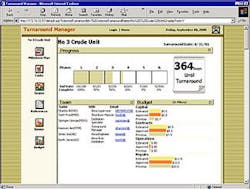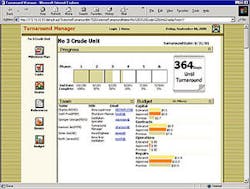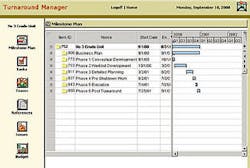Complete planning for maintenance turnarounds will ensure success
Plant turnaround is no longer a single occurrence that is the responsibility of the maintenance department. Organizations readily accept the need for multifunctional teams responsible for the planning process, as well as the need to follow a business work process during turnaround planning and execution.
Defining the work process, however, can be a challenge. Many organizations have adapted a generic process and applied it to the local environment. In theory and, fortunately, in practice, a good generic process is suitable for overhauling different types of plants and equipment, irrespective of industry.
Simply classifying turnarounds as ‘other projects‘ is a common mistake. They have many things in common with all projects, but the nature of repair work typically sets them apart from other projects. Despite the considerable improvement in techniques for predicting equipment condition, there is still an element of discovery when one opens the equipment for cleaning and inspection.
Turnaround execution tends to be more concentrated than construction projects. Turnarounds typically have their own challenges. For example, decisions are based on actual equipment condition despite the increasing accuracy of predicted conditions and corrosion rates.
The work process for planning a turnaround, therefore, must address the specific needs and challenges that are part of repairing process equipment.
Following the process is essential, but another important consideration are the benefits that technology can provide. Web-based technology can help organize and control the tasks, information, and issues critical to efficient turnaround management.
Turnaround cycle
Recognizing that a process is ongoing is the first step in defining that process; completion of one turnaround is the next cycle’s starting point. Demobilization of people and equipment often occurs when the plant returns to production with on-spec products.
While this is certainly true for a majority of the workforce, those who make up the planning team must remain in place to ensure that records are complete and that lessons learned are carried forward to the next outage.
Any work process must be a part of the company’s overall business plan to ensure that it reflects the current needs of the constantly changing business environment. The work process should also reflect the fact that the planning activities’ focus changes depending upon the stage in which the team is engaged (Fig. 1).
Fig. 2 depicts a high-level breakdown of these activities.
Many feel that the work process, starting immediately after completion of the last turnaround, will require considerably more effort and planning manpower than if it started closer to the actual turnaround date. This is not necessarily the case.
If a given number of activities must be accomplished in the planning process, it is often more efficient to perform them over a longer period of time rather than rushing to complete them in the few months immediately before the turnaround.
Turnaround teams
Organizations recognize the need for multifunctional or disciplined teams to handle the diverse activities of the planning process. This is a practical way to ensure that the disparate requirements of all those who contribute to the turnaround are reflected in the final plan.
The facts that such teams require leadership and guidance and that working as a team raises it own challenges are not always recognized. Self-directed teams often proceed in self-directed paths, which can conflict with corporate or plant requirements.
Many organizations provide guidance to these teams through a steering committee. This committee oversees progress and ensures that team efforts are channeled down the right path. In addition, they can easily stay informed about corporate, managerial, and operational decisions that will influence specific turnarounds.
Core team
Appointing a core team to handle the planning process is a monumental milestone in the process, but this is just the first step.
Working as a member of a team does not always come naturally to individuals whose traditional roles and responsibilities have been based on functional and departmental requirements.
When naming members of a core team, the organization should assess the members’ abilities to work within a team and, where needed, give them appropriate training. Not everyone, however, can be taught the skills needed to be an effective team member. Not everyone is suited to being a team player. They are not ineffectivetheir individual talents are simply best used outside a team environment.
The challenge does not only lie with team members. Those who appoint individuals to the team frequently have difficulty delegating authority along with responsibility. Avoid this ‘pass everything by me‘ syndrome to have an effective team. Team members must clearly understand that decisions are made by the team and not by individuals within the team.
Core team roles fall into two categories: those common to all members and those that depend on the individual functionality of the team member.
The core team must have a functional leader or facilitator who has responsibility for assessing the timing for issues that need resolution, ensuring that meetings are scheduled, and maintaining links with the steering committee. This assignment can vary with the type of turnaround or with the process stage. In some organizations, department representatives lead the team until the preshutdown work starts, whereupon the maintenance representative will take the lead.
Turnaround steering committee
The members of this team typically consist of the facility’s senior management. This group provides direction and guidance to the core team to ensure that the turnaround meets business needs. A more important function of this committee, however, is to ensure that the turnaround’s scope and budget are aligned.
Management often appears to set unrealistic budget expectations. Frequently, however, what appears to be a poor decision is, in fact, appropriate based on information available. The work process must, therefore, ensure that there is communication between the core team and the steering committee. The committee must keep abreast of the scope of work and current estimated costs of execution.
Better information quality will enhance the discussions and subsequent decisions. This will not solve all the budget problems, but without a regular review of scope and budget alignment, there will be little opportunity to resolve any differences.
Reviews or audits
Conducting a series of reviews or audits at intervals throughout the process will ensure that planning and execution are receiving appropriate priority. Reviews typically coincide with completion of each specific stage.
Individuals that undertake such audits are appointed by the steering committee and should be knowledgeable in turnaround matters but should not have direct responsibilities for the turnaround under review. Include someone from outside the plant or organization for some, if not all, of the audits.
The two most important audits are performed after the conceptual development and detailed planning stages. The former reviews the turnaround strategy and basic resources needed to meet the turnaround objectives. In contrast, the audit after completion of detailed planning is important since it is the final opportunity to estimate an organization’s preparedness, while also allowing some time for changes if needed.
Audits review a team’s progress compared to the projected milestone schedule using group discussions, document reviews, site visits, and meetings.
The audit team should publish and discuss a brief report with the core team and steering committee.
Milestones; business plan
Each turnaround has its own milestone schedule that details the timing of each stage and the individual tasks within each stage. This tool secures commitments from individuals or completes tasks or supplies data and information and is the primary means of measuring planning progress (Fig. 3).
Setting a long-range business plan is ongoing and establishes the long-range schedule and budgets for turnarounds and integrates them into the overall corporate plan. The steering committee is typically responsible for these activities. During the process, it considers and reviews these data and activities:
- Marketing strategy.
- Plant or unit performance data (both present and anticipated).
- Inventory capacities.
- Scheduled inspection compliance requirements.
- New regulations and standards.
- Improvement plans.
- Benchmarking results and findings.
- Market conditions.
- Inter-plant or facility coordination.
- Capital or investment planning.
- Individual plant or unit mechanical performance.
- Regulatory and legal requirements.
- Turnaround timing to ensure minimal lost profit opportunities.
- Value of downtime.
- Evaluation of which plants or units to shutdown at the same time.
The long-range business plan deliverables should include:
- A 5-year rolling turnaround schedule.
- An annual turnaround schedule.
- Forecasted turnaround budget for the next 5 years (both expense and capital).
- Long-range improvement plans.
The long-range business plan is an ongoing process. The present-day business environment in which raw material costs, product prices, and demand can change rapidly makes it inevitable that long-term plans will change. Turnaround schedules must be flexible to respond to these changes.
Turnaround conceptual development
This stage begins immediately after the postturnaround stage of the previous cycle and within the framework of the long-term business plan.
Each turnaround core team should have functional representatives. The team and steering committee should meet to define clearly the groundwork for the upcoming turnaround.
The team should consider: the type of turnaround; whether it will be restricted to activities such as catalyst change, significant capital items, and time until the next turnaround; and other factors affecting the work content. This will define the turnaround philosophy.
The core team can now concentrate on the activities for this stage:
- Form the core team and define responsibilities.
- Define turnaround philosophy and goals.
- Review previous turnaround history.
- Review lessons learned from past turnarounds.
- Identify sources of work input.
- Establish major work items, both expense and capital.
- Establish the value of plant or unit lost production.
- Develop work list criteria based on the philosophy.
- Recognize hazardous operations (‘HazOp‘) and reliability requirements.
- Review process plant performance, past and present.
- Develop contractor strategy.
- Create front-end loading strategy.
- Develop cost control and tracking process.
The conceptual development deliverables include:
- Turnaround philosophy.
- Preliminary work list.
- Basic cost estimates (±30%).
- Estimated duration.
- Turnaround preparation milestone plan.
- Manpower forecast for turnaround planning resources.
- Organization structure.
- Quality assurance, quality-control requirements.
- Stage report and audit schedule.
- Milestone plan.
At the end of this stage, deliverables are presented to the steering committee for guidance and agreement. The philosophy is formalized and signed by all core team members, as well as the preliminary work list used to establish a cost estimate for the turnaround, usually ±30%.
Another critical deliverable is the milestone plan. It lists the key checkpoints and delivery dates for the planning cycle and forms the basis for forecasting planning resources. It forms the commitment schedule for all functions.
The audit schedule is an integral part of the milestone plan. Together with the work process, it provides the basis for measuring progress.
The steering committee and core team should establish an agreement before proceeding to the next stage. This is how the turnaround’s scope aligns with the budget. This is a critical aspect of turnaround success. If the scope does not align initially, then one should note exceptions, rework plans, and resolve differences before proceeding to the next stage.
This stage is usually short (2-3 months) and, for major turnarounds, is typically completed 4-6 months after the previous turnaround. Even for smaller turnarounds with no major material lead times, this stage should start immediately after the last turnaround, although completion of this stage can be 12-15 months before starting the next turnaround.
Turnaround work development
During this stage, all work list inputs are gathered and assembled while the organization and schedule continue to develop. Continuous maintainability, reliability, and constructability input, combined with reviews of the work list criteria and philosophy, ensure that the scope of work is focused.
All work list proposals must pass through the core team for review and impact assessment. The core team’s activities should focus on:
Firming of all turnaround work inputs which include:
- Risk-based inspection and reliability items.
- Capital works.
- Compliance items.
- HazOp study outputs.
- Operational requirements.
- Process engineering requirements.
- Environmental, safety, and health needs.
- Maintenance requirements.
- Maintainability, reliability, and constructability reviews.
- Resolution of conflicting needs.
- Long lead-time material procurement.
Work development deliverables include:
- Integrated plan (schedule, equipment, and resources).
- Preliminary critical path schedule.
- Refined budget estimate (±20%).
- Updated preliminary and approved work list.
- Long lead-time materials ordered.
- Critical lift plans.
- An additional work approval process.
- Work scope closed.
- Stage report.
- Review or audit report.
As work is defined, the critical path schedules are generated to evaluate alternative execution methods. This will ensure that the most cost-effective approach to minimum downtime is used.
Again, at the end of this stage, the core team presents these deliverables to the steering committee for guidance and buy in. The next stage is started once everyone agrees to this stage.
This stage should be completed 12-15 months before the shutdown.
Turnaround detailed planning
This is the point at which detailed planning occurs. This stage helps ensure that all necessary work during the turnaround is incorporated and integrated into the plan. This should include all capital work and the operational shutdown and startup sequences.
The work must be integrated; failure to do so will cause the turnaround to overrun both budget and duration. This does not necessarily mean that responsibility for execution must be integrated. This depends on the turnaround’s complexity and nature.
The turnaround execution team typically handles internal equipment modifications and unit piping changes. Major plant modifications in which the work can be easily separated can be handled by a project organization.
The core team has the responsibility to ensure that the impact of all work is understood and fully integrated into the plan.
The work list should be finalized 4-6 months before the shutdown date; a key role of the core team is to ensure that this happens. The core team establishes cut-off dates for turnover of capital items that must be adhered to. This ensures an opportunity to demonstrate what influence this work will have on the overall plan. This final work list is the basis for the final budget estimate that should now be ± 10%.
On stream inspection activities are closing at this time to ensure that the results are interpreted and appropriate action integrated into the plan.
A work process must be in place to control, review, and, if appropriate, approve additional work that arises after the work list is finalized. This additional work could be an oversight or that which arises during execution.
During this stage, the core team’s activities should focus on:
- Final work list.
- Final plan for equipment cleaning and personnel entry.
- Contracting plan in place and all major contracts let.
- Critical-path schedule.
- Detailed execution plans.
- Detailed safety plan.
- Additional work approval process.
- Turnover of all capital work.
- Completion of materials procurement plan.
- Final estimate.
- Definition of format and frequency of performance and progress reports.
The detailed planning deliverables include:
- Integrated execution plan (finalized on critical and sub-critical work).
- Final budget estimates (±10%).
- Final work list.
- ‘What if‘ scenarios.
- Lifting plans.
- Mobile equipment requirements.
- Detailed shop loading plans.
- Review or audit report.
The core team presents these deliverables (primarily the execution plan and budget estimate) to the steering committee. The budget is the best estimate based on the finalized work list and execution plan that the core team develops.
A sound estimating methodology for turnarounds includes a provision for contingencies. Estimates should forecast expected costs, not match a preset budget. If the budget and scope are not in alignment, then one or the other must be changed.
The audit function at the end of this stage is the most critical because it is the last realistic opportunity to take action that will affect the turnaround’s outcome. If possible, the audit team should include ‘out-of-plant‘ personnel to ensure that a conflict of interest does not occur. The audit team presents the results to the core team and steering committee, which should then jointly agree upon any necessary corrective action.
It is essential to complete this detailed planning stage 4-6 months before the turnaround.
Preturnaround work
This stage occurs right before full-scale execution. Preturnaround work focuses on training and orientation needs, mobilization, final execution plans, and preshutdown work. Operations, maintenance, and contractors must be completely aligned. This is an opportunity for all parties to understand the work to be done, the sequence and details of the shutdown process, and to prepare for entry.
During this stage, the core team’s activities should focus on:
- Safety plan implementation.
- Operations training.
- Maintenance and contractor training and orientation.
- Team building.
- Environmental, safety, and management of change (MOC) requirement review.
- Beginning the prefabrication work.
- Beginning the on-site pre-shutdown work.
- Detail of shutdown and unit clean-out sequences.
- Prepare temporary connections.
- Identify blind locations and hang the blinds.
- Install temporary offices, stores, and tool houses.
- Mobilize the execution team.
- Cost tracking and reporting.
- Detailed execution plan.
- Shutdown and clean-out plan.
- Work performance.
- Turnovers.
- Start-up plan.
The preturnaround deliverables include:
- Final execution plan.
- Completion of preshutdown turnaround work.
- Training the execution team.
- Developed turnaround organization charts.
- Creation of a reporting plan.
- Completion of field mobilization.
- Finalized shutdown meeting procedures.
- Beginning of communications-alignment meetings.
- Review or audit report (optional).
Mobilization includes all aspects of the logistics involved with the temporary workforce increase. Training should ensure that personnel can operate and maintain new equipment or facilities that are installed.
Communication is important to the turnaround and can influence success. In addition to being a means of advising personnel on logistical matters, items such as turnaround newsletters and flyers can also communicate overall progress.
This stage should be completed 2 weeks to 3 months before the turnaround.
Turnaround execution
During this stage, the core team’s focus moves from planning to execution. The individual responsible for execution should assume leadership of the team. This stage begins as feed is reduced and includes shutdown, preparation for entry, work execution, and start-up, all of which should be covered in the detailed plan.
During execution, the core team’s activities should focus on:
- Unit and equipment shutdown and preparation for entry.
- Daily turnaround meetings.
- Schedule reviews and updates.
- Daily cost tracking and reporting.
- Documenting MOC requirements.
- Additional work review and processing.
- Tracking additional work and scope changes.
- Ensuring that records reflect as-found conditions.
- Documenting all repairs.
- Documenting all inspections.
- Prestart-up safety review.
Execution deliverables include:
- Turnaround executed per the plan.
- Objectives met.
- Contingency plans reassessed as needed.
- Prestart-up safety review.
- Start-up on schedule.
- Release to operations.
An important aspect of executioncontrol of scopeconsists of two elements:
- Additional work requests. This covers obvious oversights from the work list and work that becomes apparent during execution, such as unanticipated replacement of equipment internals. This work must follow an additional work approval process, although the daily shutdown meeting can resolve this process.
- Scope growth of identified work list items. This category includes items such as ‘replace six trays‘ becoming ‘replace nine trays.‘ Although this represents additional work, it is not outside the work list’s scope. Typically some allowance for these contingencies is made in the estimates. Scope growth should be documented for cost control purposes but does not necessarily have to pass through the additional work-approval process (Fig. 4).
A key aspect of execution is a daily shutdown meeting. It is essential to limit attendance at these meetings. Typically, only the core team should attend on a regular basis. The meetings should be brief and concentrate on resolving work scope changes.
This stage is complete when the plant is started up and producing on-specification product.
Postturnaround
This stage covers demobilization, documentation, cost reports, and most importantly, lessons learned that could be carried forward to the next turnaround. Executing this stage in a timely manner with a quality result will depend on data collection effectiveness during the execution stage.
It is vital that the core team have the time to complete this aspect of their responsibilities. Successful completion of this stage can have a major impact on the next turnaround.
During the postturnaround stage, the core team’s activities should focus on:
- Demobilization of contractors.
- Post-turnaround unit and lay-down area clean up.
- Resolution and disposal of excess material.
- Repair and inspection history reports.
- Updating the turnaround historical database.
- Postturnaround MOC requirements.
- Freezing the turnaround accounts.
- Issuing the final cost report.
- Lessons learned and recommendations for future turnarounds.
- Preparing the final turnaround report.
The deliverables include:
- Postturnaround unit and lay-down area clean up.
- Planned run length.
- Improvement opportunities.
- Final reports.
- Final audit report of performance and adherence to the work process.
This stage should be completed 1-2 months after the turnaround.
Performance measure; success
The organization must measure turnaround performance and observe trends. As with all measurements, a single indicator can mislead. It is, therefore, necessary to design a number of criteria to provide a balanced indication of performance. Table 1 lists some suggested criteria.
Having a work process does not guarantee a successful turnaround, but benchmarking considerably reduces the likelihood of failure. Organizations that complete turnarounds on time, on budget, and without surprises invariably have a defined work process and adhere to it.
Following the process is the key; today’s technology provides tools that allow organizations to specify the process, define the tasks, and measure adherence. Web-based technology is an ideal medium to organize and control the multitude of tasks, information, and issues that are critical to the successful completion of turnarounds.
Rod Oliver is a senior consultant for Meridium Inc., Roanoke, Va., with more than 30 years’ experience in the refining and process industries. Oliver has worked in refineries in the Middle East, the Philippines, Korea, and Malaysia as well as in corporate offices in the UK and US. He has held a variety of managerial positions in the maintenance, engineering, inspection, and general management fields. Before his current consulting position with Meridium, Oliver was responsible for providing instruction on maintenance and reliability best practices throughout a major international oil company.






